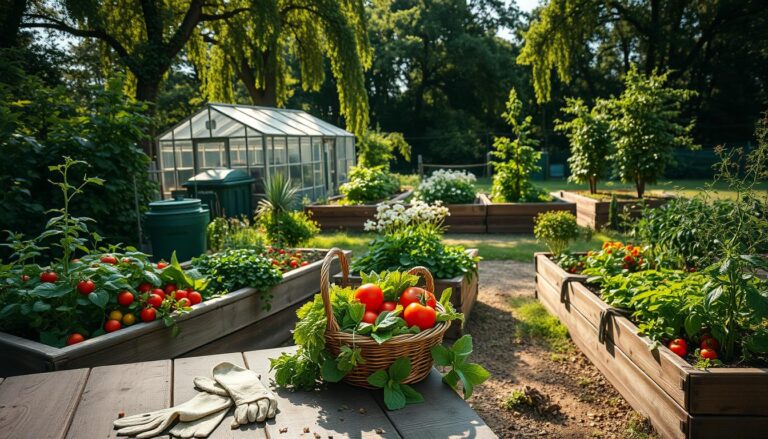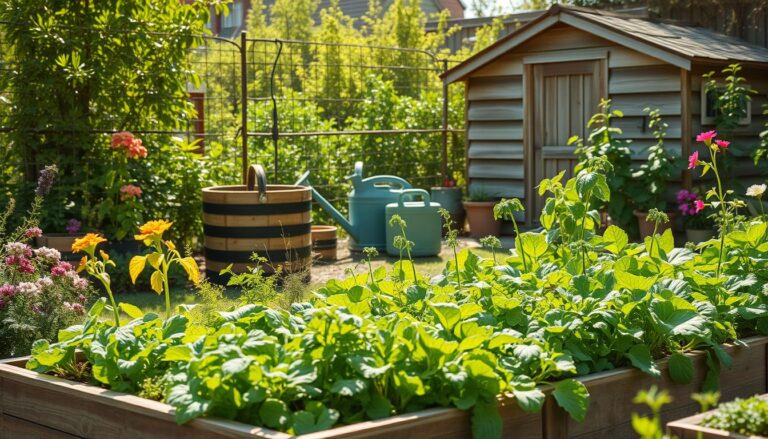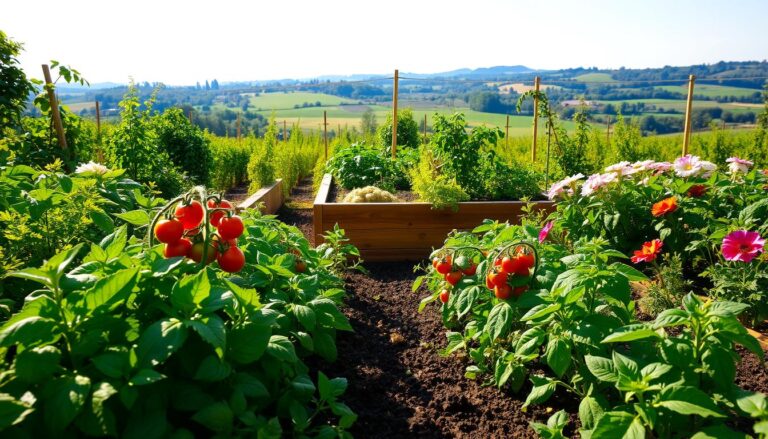Growing organic herbs indoors is rewarding. It brings fresh flavors and scents into your home. With the right care, you can have herbs all year, no matter the season or where you live.
Indoor herb gardening brings greenery to your space. It also improves air quality and lowers stress. Knowing the key factors that influence herb growth is crucial for success.
This article will help you grow herbs indoors successfully. Follow these tips for successful indoor herb cultivation. You’ll soon have a thriving garden that boosts your cooking.
The Benefits of Growing Your Own Organic Herbs Indoors
Growing herbs indoors has many perks. You get fresher ingredients and save money. It also makes your cooking better, boosts your health, and helps the planet.
Health and Culinary Advantages
Indoor herb growing means you always have fresh herbs. This makes your food taste better. Plus, you avoid pesticides and chemicals.
Fresh herbs are packed with nutrients. They keep their oils and antioxidants better.
Environmental Benefits
Indoor herb gardens cut down on carbon emissions. They also support sustainable living. You can reuse containers and materials.
Cost Savings Over Store-Bought Herbs
An indoor herb garden saves you money. You don’t have to buy wilted or expired herbs. Here’s how it compares:
| Herb | Average Store Price (per pack) | Initial Investment for Indoor Garden | Long-Term Savings |
|---|---|---|---|
| Basil | $2.50 | $5 (initial setup) | Up to 50% on annual basil purchases |
| Mint | $3.00 | $5 (initial setup) | Up to 60% on annual mint purchases |
| Cilantro | $2.00 | $5 (initial setup) | Up to 40% on annual cilantro purchases |
Investing in an indoor herb garden is smart. You get healthier, fresher herbs. It’s good for the planet and your wallet.
Essential Supplies for Your Indoor Herb Garden
To start a thriving indoor herb garden, you need the right supplies. You’ll need to pick the best containers, choose organic soil and amendments, and get basic tools and equipment.
Container Options for Different Spaces
The containers you pick are key for your indoor herb garden’s health. Think about the space you have and what your herbs need.
- For small spaces, choose compact or hanging containers to save space.
- For herbs like rosemary or sage that need deep roots, pick deeper pots.
- Make sure your containers have holes for drainage to avoid waterlogged soil.
Organic Soil and Amendments
The soil is the base of your indoor herb garden. Choose high-quality, organic potting soil made for indoor plants.
Key considerations for organic soil and amendments:
- Find soil mixes without synthetic fertilizers and pesticides.
- Add organic amendments like compost or worm casting to make the soil richer.
- For best herbs for indoor cultivation, a balanced soil pH is important.
Basic Tools and Equipment
Having the right tools makes caring for your indoor herb garden easier.
- A watering can or spray bottle for precise watering.
- A small trowel or spoon for planting and mixing soil.
- Pruning scissors or clippers for trimming and harvesting herbs.
By focusing on these essential supplies, you’ll create a thriving indoor herb garden. It will add fresh flavors and beauty to your home, perfect for herb gardening indoors.
Selecting the Best Herbs for Indoor Cultivation
To make your indoor herb garden a success, choose herbs that do well indoors. The right herbs can greatly improve your gardening experience. Knowing which herbs are best for indoor growing is crucial.
Easiest Herbs for Beginners
Beginners should start with easy-to-grow herbs. Herbs like basil, mint, and chives are great for beginners. They are popular and easy to care for. Following tips for successful indoor herb growing can also help.
Space-Efficient Herb Varieties
For small indoor gardens, choose compact herbs. Herbs like thyme, oregano, and parsley grow well in small pots. They are perfect for maintaining an indoor herb garden in tight spaces.
Year-Round Indoor Performers
Some herbs grow well indoors all year. Herbs like mint, chives, and cilantro can grow indoors any time of the year. They provide a steady supply of fresh herbs.
| Herb | Ease of Growth | Space Requirement | Year-Round Growth |
|---|---|---|---|
| Basil | Easy | Medium | No |
| Mint | Easy | High | Yes |
| Chives | Easy | Low | Yes |
| Thyme | Moderate | Low | No |
| Oregano | Moderate | Low | No |
| Parsley | Easy | Medium | No |
| Cilantro | Moderate | Low | Yes |
Creating the Perfect Growing Environment
To make indoor herbs grow well, you need to know what they like. This means looking at a few important things. These help your herbs stay healthy and grow well.
Understanding Light Requirements
Light is key for growing herbs indoors. Most herbs need bright, indirect light to grow. You can place them near a window that faces south or use grow lights.
But, don’t let them get too much direct sunlight. It can burn their leaves.
Temperature and Humidity Considerations
Herbs like daytime temperatures between 65-75°F (18-24°C). They also do better in cooler nights. Keeping the temperature steady is important.
They also like a bit of humidity, between 40-60%. You can use a tray with water and pebbles or a humidifier to keep the air moist.
Air Circulation Needs
Good air flow is crucial for healthy herbs. It stops fungal diseases by keeping leaves dry. It also helps plants get enough carbon dioxide for photosynthesis.
To get better air flow, use fans or make sure plants have enough space.
By paying attention to these details, you can make a great place for your herbs to grow. This will lead to a lot of harvest and a lively indoor garden.
Tips for Growing Organic Herbs Indoors Successfully
Growing organic herbs indoors is an art that requires a few key tips. To have a successful indoor herb garden, focus on the basics. This includes soil preparation, planting, and spacing.
Soil Preparation Techniques
Choosing the right soil is crucial for indoor herb gardening. Use a high-quality potting mix that’s full of organic matter. Don’t use garden soil from outside, as it can make the soil hard and prevent water from draining.
To make the soil better, add compost or worm casting. These organic materials give your herbs the nutrients they need to grow well.
| Soil Component | Function | Benefit |
|---|---|---|
| Compost | Rich in nutrients | Promotes healthy growth |
| Worm Casting | Microbial activity | Improves soil structure |
| Peat Moss | Retains moisture | Reduces watering frequency |
Proper Planting Methods
Choosing the right containers is key when planting herbs indoors. Pick pots that are 6-8 inches deep to give roots room to grow. Make sure the pots have holes for drainage to avoid waterlogged soil.
When planting, gently remove the herb from its container. Plant it at the same depth as before and water well after.
Spacing Guidelines for Indoor Herbs
Herbs need enough space to grow well indoors. Too close together can cause problems like fungal diseases. Most herbs should be 4-6 inches apart. But bigger herbs like basil might need more room.
By following these tips, you can enjoy a rich harvest of organic herbs indoors. Success in indoor herb gardening comes from paying attention to details and being flexible with your plants’ needs.
Watering Strategies for Healthy Indoor Herbs
The right watering strategy is key to growing healthy indoor herbs. It’s important to water them just right. This keeps the balance needed for herbs to grow well indoors.
Signs of Overwatering and Underwatering
Too much or too little water can harm your herbs. Signs of overwatering include yellow leaves, soft stems, and root rot. Underwatering shows as dry, crispy leaves and slow growth. It’s vital to watch your herbs and adjust your watering schedule.
| Condition | Overwatering Signs | Underwatering Signs |
|---|---|---|
| Leaves | Yellowing or droopy | Dry, crispy |
| Stems | Soft, mushy | Hard, woody |
| Roots | Root rot | Dry, brittle |
Self-Watering Options for Busy Gardeners
Self-watering planters are great for busy people. They have water reservoirs that feed plants as needed. This helps avoid overwatering and underwatering, especially for herbs that like steady moisture.
Water Quality Considerations
The water quality affects your indoor herbs’ health. Tap water with too much chlorine or fluoride can harm them. Use filtered or rainwater for the best results.
Knowing the signs of bad watering, using self-watering planters, and choosing good water quality helps. This keeps your indoor herb garden healthy. It also makes your cooking taste better and supports a sustainable lifestyle.
Organic Fertilizing Methods for Indoor Herbs
To keep your indoor herb garden healthy, learning about organic fertilizing is crucial. Organic fertilizers give your herbs the nutrients they need without the harm of synthetic chemicals. Using organic methods can make your herbs taste better, smell stronger, and grow healthier.
Homemade Organic Fertilizer Recipes
Making your own organic fertilizers at home can save money and be fulfilling. One easy recipe is compost tea, a liquid made by soaking compost in water. It’s a gentle, nutrient-rich fertilizer. Another good option is using eggshells crushed into a fine powder. It adds calcium and minerals that help your herbs grow.
A famous gardening expert once said:
“The use of organic fertilizers is not just a trend; it’s a return to the natural methods that have been used for centuries to nourish the soil and promote healthy plant growth.”
Fertilizing Schedule and Techniques
Having a regular fertilizing schedule is key for your herbs’ health. Most herbs need fertilizing once a month when they’re growing. But, this can change based on the herb and where it’s growing. It’s also important to use the right ways to fertilize, like top-dressing with compost or using liquid fertilizers when you water.
Signs of Nutrient Deficiencies
It’s important to know the signs of nutrient deficiencies in your herbs. Yellow leaves often mean a lack of nitrogen, and stunted growth can mean a lack of phosphorus or potassium. By watching your herbs and adjusting your fertilizing schedule, you can stop deficiencies and get a great harvest.
For indoor herb gardening tips, remember to balance fertilizing with other care like watering and pruning. This will help your indoor herb garden thrive.
Pruning and Harvesting Your Indoor Herbs
To keep your indoor herb garden thriving, you need to know how to prune and harvest. Regular pruning helps your plants grow bushier. Harvesting at the right time ensures your herbs taste and smell their best.
Proper Pruning Techniques for Bushier Growth
Pruning is key in indoor herb gardening. Pinching off stem tips makes your herbs grow denser. For basil and mint, pruning stops them from flowering and becoming too long. Always use clean scissors or pruning shears to avoid spreading diseases.
Harvesting Methods That Promote Regrowth
Harvesting your herbs right is as important as pruning. For leafy herbs like cilantro and parsley, pick leaves as you need them. For rosemary and thyme, take sprigs. Always cut from the top to encourage new growth and prevent the plant from becoming woody.
Preserving Your Herb Harvest
To enjoy your herbs all year, consider preserving some. Drying is a simple method that works for many herbs. You can also freeze herbs in ice cube trays with water or olive oil for later use. Making herb butters or oils is another way to add fresh flavor to dishes even when your herbs are not in season.
| Herb | Pruning Technique | Harvesting Method |
|---|---|---|
| Basil | Pinch off stem tips | Harvest individual leaves |
| Mint | Trim back after flowering | Harvest sprigs |
| Rosemary | Prune lightly in spring | Harvest sprigs |
Troubleshooting Common Indoor Herb Garden Problems
Even with the right care, indoor herb gardens can face problems. Knowing how to fix these issues is key to keeping your garden healthy and vibrant.
Dealing with Pests Organically
Indoor herb gardens can get pests like aphids, spider mites, and mealybugs. Use neem oil or insecticidal soap to fight these pests. Check your plants often to spot infestations early.
- Neem oil: Works well against many pests
- Insecticidal soap: Safe for plants but kills pests
Preventing and Treating Plant Diseases
Diseases can spread fast in indoor gardens, especially with high humidity or bad air flow. Make sure plants have good air flow to prevent diseases. If you see disease, cut off sick leaves or stems to stop it from spreading.
| Disease | Symptoms | Treatment |
|---|---|---|
| Root Rot | Yellow leaves, soft stems | Improve drainage, water less |
| Powdery Mildew | White powder on leaves | More air flow, use fungicide |
Reviving Struggling Herb Plants
If your herbs are struggling, it might be from too little water, too much water, or not enough nutrients. Check the soil moisture and adjust your watering schedule as needed. Use a balanced, organic fertilizer to give them the nutrients they need.
“The key to successful indoor herb gardening is not just providing the right conditions but also being prepared to troubleshoot when issues arise.”
Growing Guide for Popular Indoor Herbs
Indoor herbs can add flavor to your meals all year. Growing your favorite herbs indoors is easy. This section covers the needs and tips for basil, mint, rosemary, cilantro, parsley, thyme, and oregano.
Basil: The Indoor Gardener’s Favorite
Basil is a top choice for indoor gardens. It’s easy to grow and versatile in cooking. Knowing its light, temperature, watering, and feeding needs is key.
Light and Temperature Requirements
Basil needs lots of light to grow well. It prefers temperatures between 65°F to 75°F. Place your basil near a sunny window or under grow lights for enough light.
Watering and Feeding Tips
Keep the soil moist but not too wet. Basil grows well with regular fertilization. Use a balanced, water-soluble fertilizer for healthy growth.
Harvesting and Using Basil
Pinch off flower buds to encourage leaf growth. Harvest leaves or stems as needed. Basil is essential in pesto and caprese salads.
Mint: Containing an Enthusiastic Grower
Mint is a hardy herb for indoor gardens. It’s refreshing but can spread quickly. It’s best kept in a container.
Container Selection for Mint
Choose a deep container for mint’s roots. Use a container without drainage holes and with a wide mouth to prevent spreading.
Care Requirements
Mint likes moist soil and partial shade to full sun. It’s easy to care for but needs regular pruning to stay bushy.
Varieties to Try Indoors
Try peppermint, spearmint, and chocolate mint indoors. Each has a unique flavor and aroma.
| Herb | Light Requirement | Watering Needs |
|---|---|---|
| Basil | Full Sun | Consistent Moisture |
| Mint | Partial Shade to Full Sun | Moist Soil |
| Rosemary | Full Sun | Well-drained Soil |
Rosemary: Mediterranean Herb for Your Kitchen
Rosemary is a fragrant, drought-tolerant herb for indoor gardens. It’s great for roasted meats and vegetables.
Creating the Right Environment
Rosemary needs well-drained soil and full sun. It’s cold-hardy but may need protection from extreme temperatures.
Watering and Feeding Schedule
Let the soil dry slightly between waterings. Rosemary doesn’t need much fertilizer. A light feeding once a month is enough.
Pruning for Bushy Growth
Regular pruning keeps rosemary bushy and prevents legginess. Harvest sprigs as needed for cooking.
Cilantro and Parsley: Leafy Herbs for Cooking
Cilantro and parsley grow fast indoors. They add fresh flavor to many dishes.
Growing from Seed
Both cilantro and parsley grow well from seed. Sow seeds directly into pots, keeping the soil moist until germination.
Succession Planting Techniques
Sow seeds every 1-2 weeks for a continuous harvest. This ensures a steady supply of fresh leaves.
Harvesting Methods
Harvest leaves or stems as needed. For cilantro, harvest before it flowers for the best flavor.
Thyme and Oregano: Low-Maintenance Options
Thyme and oregano are easy to care for indoors. They’re great for seasoning various dishes.
Light and Soil Requirements
Both thyme and oregano prefer well-drained soil and full sun to partial shade. They’re drought-tolerant.
Watering Guidelines
Water when the top inch of soil feels dry. Avoid overwatering to prevent root rot.
Harvesting and Using
Harvest sprigs or individual leaves as needed. Thyme and oregano are excellent in soups, stews, and as seasoning for meats and vegetables.
Conclusion
By following the tips for growing organic herbs indoors, you can have a fresh harvest at home. It’s important to know what each herb needs and keep the right growing conditions. Also, using organic practices helps your plants grow strong and healthy.
These tips will help you create a vibrant indoor herb garden. It will make your cooking better and add happiness to your kitchen.
FAQ
What are the best herbs to grow indoors for a beginner?
How often should I water my indoor herbs?
Can I use regular potting soil for my indoor herbs?
How much light do indoor herbs need?
How can I fertilize my indoor herbs organically?
Why are my indoor herbs turning yellow or dropping leaves?
Can I grow herbs indoors year-round?
How do I prune my indoor herbs for bushier growth?

Sortemdia nasceu com o propósito de trazer alegria e oportunidades para todos por meio de sorteios gratuitos de prêmios incríveis. O site tem como missão oferecer experiências acessíveis, divertidas e justas para quem deseja concorrer a produtos, serviços e brindes sem pagar nada por isso. Acreditamos que a sorte pode bater à porta de qualquer pessoa — e no Sortemdia, ela pode chegar com apenas um clique.



